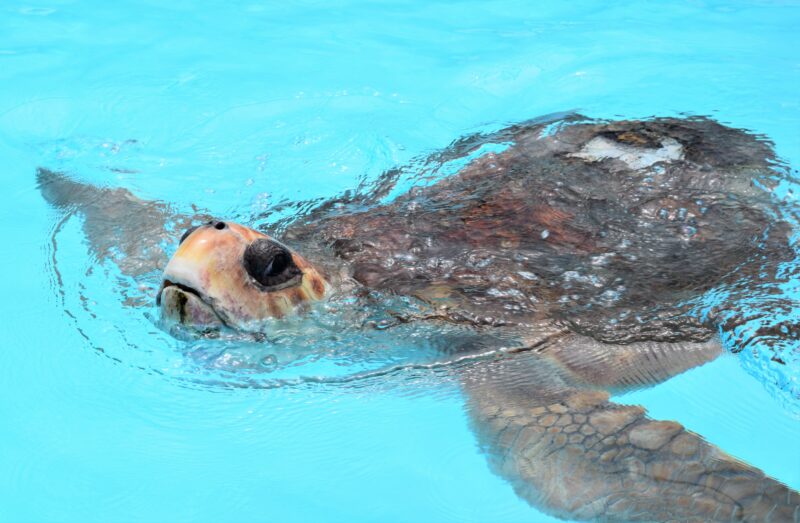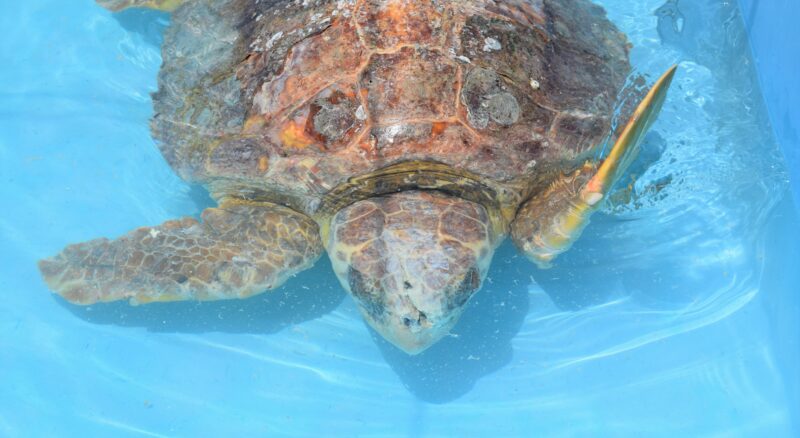Boating and Sea Turtles
Boating can be a fun, safe distancing activity for these stressful times we are experiencing. Unfortunately it can be a hazardous activity for sea turtles and other sea creatures. Hundreds of sea turtles are injured due to boat strikes every year. Sea turtles need to surface for multiple reasons: to breathe, basking, and to feed in shallow waters. Breeding and nesting seasons run late spring through early fall, leading to more boat strikes due to the increased number of turtles in near shore waters.

Since The Turtle Hospital opened in 1986, we have seen many turtles with boat strike injuries. The most famous is a green sea turtle named Bubble Butt. He was rescued March 25, 1989 from Long Key. He was the first turtle we saw with Positive Buoyancy Disorder, which is when a turtle floats at the top of the water and is unable to dive. Because he was the first turtle with this disorder, it’s now nicknamed Bubble Butt Syndrome. The force of the boat strike damages the shell, which is bone, and the keratin layer on the outside of the shell. If the damage is deep enough, it can also affect the internal organs and their spine. A sea turtle’s spine is fused to the inside of the upper shell. This can lead to nerve damage and paralyzed rear flippers and tail. Also, their lungs are different than ours. They are more like a sponge and this damage may not allow their lungs to work properly, especially at expelling air. This Bubble Butt Syndrome cannot be fixed with medication or surgery and means that these turtles are deemed non-releasable. To help them in captivity, we add weights to the outside of the shell to allow the turtle to dive and rest on the bottom. The weights are attached with a marine epoxy to the outer keratin layer of the shell (called scutes). Even with the weights, the turtle can never be released back in the wild because they shed the outer keratin layer during growth spurts. A younger turtle sheds its scutes more often because they are growing more rapidly. As they come into adulthood, their growth slows down but never stops. Every time they shed the scutes, the weights fall off and they start floating again. So we reattach the weights, which is why they’re non-releasable. When in the wild, floating makes them more vulnerable to predators or perhaps another boat strike.

One of our current turtles, Madea, is an adult female loggerhead sea turtle with Bubble Butt Syndrome. She came to the hospital on May 15, 2019. She was found floating by rescuers near No Name Key with a boat strike and flipper wounds. The rehab team on arrival said that it was an older boat strike and had probably happened a few weeks before she was rescued. She was emaciated, having been floating for so long and not being able to eat. Her carapace was damaged, and her back flippers and tail paralyzed due to the spinal cord damage. Because of the damage and infection, we cleaned the wound and used honey to pack the wound. Honey is a natural topical antibiotic. Regular honey can be used, as well as honey comb and Medi-honey. She was also given broad-spectrum antibiotics and pain medication. She started eating healthy food and healing! She has received her first weight fitting and is doing very well- learning how to maneuver with her front flippers, diving, eating, and resting. She can be adopted out to an aquarium or zoo to be an ambassador to teach people about boat strikes and boating safety. Madea is a survivor!

Just recently, we rescued Coco. Coco is an adult female loggerhead rescued on April 17, 2020 with a propeller strike to the head. Propeller wounds are very distinctive due to their telltale slashes. Coco’s wound is severe and we suspect neurological damage. This strike is not fresh- it may have happened a few weeks ago. Her calcium levels are high, which indicates she was probably preparing for nesting. During an ultrasound, we discovered egg follicles. No eggs at this time, but she might have been preparing to nest. We will keep and eye on her and do follow-up ultrasounds to check on egg progress. Nothing else seems to have been wrong with her besides the boat strike. We are currently trying to save Coco, focusing on wound care and getting her appetite back. You can follow her story on her patient page here.
Things you can do to help:
- Always boat slowly with vigilance through sea turtle habitat: shallow-water, sea grass areas, and over deep water on calm days when they’re surfacing and basking.
- Keep a look out. Polarized sunglasses help with the glare on the water.
- Go slow in active sea turtle areas and close to the shore line – especially during breeding and nesting season (March 1st – October 31st)
- Install a prop safety guard
If you find an injured or distressed sea turtle, report it immediately!
- In the Florida Keys, call The Turtle Hospital at 305-481-7669.
- Anywhere in Florida, call Florida Fish and Wildlife Conservation Commission (FWC) at 888-404-3922 or *FWC or #FWC on a cell phone.
- Contact Coast Guard on VHF Channel 16
Remember to always keep a look out! Not only for sea turtles, but also dolphins, manatees, and other wildlife we share the oceans with!
Comments are closed.


